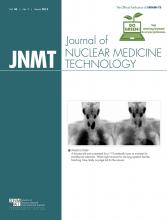Abstract
Diffuse 99mTc-sestimibi uptake in the lungs is a sign of serious pathology and merits further work-up. We present a case in which diffuse lung uptake was incidentally found on a parathyroid scan.
We present a case of unexpected diffuse lung uptake on a 99mTc-sestamibi scan. The differential diagnosis for this finding includes many serious conditions and merits further investigation.
CASE REPORT
A 64-y-old man presented for a 99mTc-sestambi scan to evaluate for parathyroid adenoma. His serum calcium level was 11.0 mg/dL, and his parathyroid hormone level was 135 pg/mL. He underwent a 99mTc-sestamibi parathyroid scan (810.3 MBq [21.9 mCi]). After a 15-min uptake period, early planar and SPECT images of the neck and upper to mid thorax were obtained. At 2 h after 99mTc-sestamibi administration, delayed planar and SPECT images were obtained. The images revealed persistent increased uptake in the inferior posterior aspect of the left lower lobe of the thyroid gland that was suggestive of a parathyroid adenoma. However, persistent diffuse lung uptake was present on the early and delayed images (Fig. 1).
Early (A) and delayed (B) static images of 99mTc-sestamibi parathyroid scan. Focus of persistent increased activity suggestive of parathyroid adenoma is seen in inferior pole of left lobe of thyroid gland. Diffuse increased uptake in lungs is suggestive of underlying disease.
This finding necessitated further work-up. The patient had an extensive cardiac history, including atrial fibrillation and severe nonischemic systolic dysfunction requiring pacemaker implantation. He initially underwent coronary CT angiography, which revealed a pericardial effusion and mild 3-vessel coronary artery disease (Fig. 2). Subsequent exercise-stress 99mTc-sestamibi myocardial perfusion imaging failed to demonstrate any ischemic changes but did reveal an ejection fraction of only 30%, consistent with the history of systolic dysfunction. Cardiac catheterization revealed equalization of the right and left ventricular diastolic pressures, which is compatible with end-stage restrictive heart failure, making surgical removal of his parathyroid adenoma too risky. The patient was placed on the waiting list for a cardiac transplant.
CT coronary angiogram showing diffuse irregular calcification at proximal left anterior descending artery and nonstenotic calcification in proximal left circumflex arteries (A, arrows). There was also noncritical stenosis in right coronary artery (B, arrow) and sizeable pericardial effusion (B, arrowhead)
DISCUSSION
The possible mechanism for uptake of 99mTc-sestamibi uptake in the lungs can be explained by the chemical characteristics of 99mTc-sestamibi. The radiotracer is a positively charged ligand that has natural affinity for negative transmembrane potentials, specifically the mitochondria (1). Patients with chronic heart failure have an increased predisposition for pleural effusions and consequent pulmonary injury. Lung uptake of 99mTc-sestamibi can also occur as a result of left ventricular failure, which causes the radiotracer to persist in the lung arterioles rather than reaching the systemic circulation and physiologic distribution (2). However, the differential diagnosis includes many other serious conditions, such as systemic lupus erythematosus, pulmonary embolism, amyloidosis, sarcoidosis, and cancer. In view of these etiologies for diffuse lung uptake, it is vital to definitively establish the exact cause.
This patient’s history pointed to a cardiac etiology, specifically systolic dysfunction, which was confirmed by the subsequent work-up. Previous studies, such as the one by Bacher-Stier et al., found that postexercise lung uptake of 99mTc-sestamibi correlated with severe coronary artery disease and reduced left ventricular function (3). An interesting finding in our patient was that he lacked severe coronary artery disease despite having end-stage restrictive cardiomyopathy. A study by Giubbini et al. showed that 99mTc-sestamibi lung uptake was significantly higher in patients with left ventricular dysfunction than in healthy subjects. Moreover, severely compromised left ventricular function and an ejection fraction lower than 40% demonstrated an increase in lung uptake (4). However, a marked delay in lung clearance, as evident on the 2-h image (Fig. 1B), cannot always be explained by simple association between systolic heart failure and 99mTc-sestamibi lung uptake. Other causes should be considered as well.
CONCLUSION
99mTc-sestamibi is a positively charged ligand that has a natural affinity for negative transmembrane potentials, specifically the mitochondria. Conditions such as congestive heart failure, malignancy, pulmonary embolism, and autoimmune diseases are associated with increased pulmonary uptake. Regardless of which disease process is evident, further investigation is warranted in any case of increased lung uptake of 99mTc-sestamibi that fails to clear on delayed imaging.
DISCLOSURE
No potential conflict of interest relevant to this article was reported.
Footnotes
Published online Oct. 23, 2014.
REFERENCES
- Received for publication March 4, 2014.
- Accepted for publication June 6, 2014.









